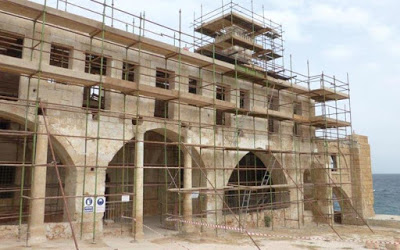The desire and dream of the Karpasites, but also of all Cypriots, to restore the historic monastery of Apostolos Andreas in the northeastern end of occupied Cyprus, came true, as in a few days, based on the plans of the School of Architecture of the University of Patras, first phase of the restoration program of the monastery.
The Technical Committee for Cultural Heritage and UNDP (United Nations Development Program) have announced that on November 7 they are organizing a visit to the media to be informed on the spot and to see the completion of phase 1 of the rehabilitation program. On the same day there will be a modest ceremony for the delivery of the church of the Monastery. According to information, the bishop of Karpasia, Christoforos, will be present at the ceremony.
On September 17, 2013, the United Nations Development Program (UNDP-PFF) signed two contribution agreements worth € 2.500.000 each, with the Church of Cyprus and the Evkaf Foundation for the Restoration of the Apostle's Monastery, respectively. Andrea.
In July 2014, a contract was signed for phase 1 of the restoration project between UNDP and the Greek Cypriot and Turkish Cypriot consortium, Messrs. Pieris Hatzipieris and Yakoup Tel. UNDP, Ali Chaklar, oversaw the implementation of the work.
The preparatory work was completed in September 2014 and the keys to the temple complex were handed over by the monastery's treasurer, Father Zacharias, to the Technical Committee for Cultural Heritage.
During phase 1, the following were done: complete structural and architectural restoration of the main church, the above complex, neighboring buildings, restoration of the carved iconostasis (iconostasis), episcopal throne and pulpit.
Silver candlesticks, copies of the old ones that were lost, will be placed in the iconostasis. The candelabra is the work of the Nousi Laboratory in Limassol, whose founder is from Ioannina, where he learned the art of silversmithing.
Also, improvements and upgrades were made to the electrical and mechanical installations in the temple and the neighboring buildings. The bell tower was dismantled because it had become dangerous and was rebuilt, as was its style, with stones from the Limassol Cubs and some of the old ones. The entrance of the temple has been restored and highlights its architecture. The floor, on which the marble was placed, has risen both outside and inside the temple. The north side of the monastery has almost been rebuilt, due to the poor condition, which left no room for restoration.
In the wooden parts it has been used invisible, (or juniper, which belongs to the cypress family), which is a local wood and has been preserved. The metal additions replaced the material that had suffered the most damage. The space where the cells were located will be used for chapels, offices and warehouses. The gynaeconite will have two levels, with a staircase leading to the ground floor of the monastery and three arches along the length. In the first phase, geotechnical surveys were carried out in the area outside the ancient chapel, which is located below the temple and the fountain. The results of the research will be used for the restoration, at a later stage, of the chapel. The project was donated by the United States Agency for International Development (USAID) for $ 25.000.
Until 1974, the monastery of the Apostle Andreas attracted thousands of pilgrims every year, especially on November 30 and August 15. Testimony of 1103 AD by the Anglo-Saxon pilgrim Seawolf, calls it "the port of the Apostle Andreas", an indication that the tradition of the Apostle Andreas was widespread from the Byzantine years. Old maps of Cyprus mention the cape called "Capo de Santo Andrea". No traces were saved from the buildings of the first temple. In their place, however, was built in the 15th century, a temple with a Gothic influence that is located low, next to the sea and is preserved to this day.
The main church, which has now been completely renovated, was built in the 19th century. The founder and first housekeeper of today's monastery is Pope John Ioannis Diakou, from Rizokarpaso. The construction of the church began in 1855. The Archbishop of Cyprus, Sophronius, inaugurated the church on August 15, 1867, which has since been established to celebrate this day.
Source: REPORTER

